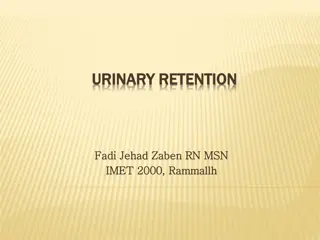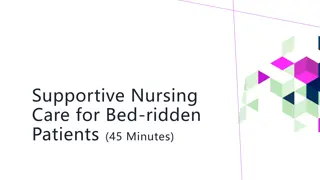The Best Urinary Incontinence– Healthy Lifestyle Bariatrics
You're looking for one of the best urinary incontinence services in the United States offered by Healthy Lifestyle Bariatrics. Gynecomastia surgery, excessive cholesterol, and other therapies involving many body modification procedures are offered. If you need more information, please visit our webs
0 views • 9 slides
Understanding Urinary Incontinence in the Elderly
The urinary system plays a vital role in regulating blood volume, pressure, and waste excretion. Urinary incontinence in the elderly can be caused by weak bladder muscles or neurological issues. The bladder consists of 4 layers, each serving a specific function. Normal voiding frequency and bladder
0 views • 50 slides
Understanding Medications and Pharmacological Therapy for Urinary Incontinence
This learning module for clinicians discusses the physiology of bladder control, age-related changes in the genitourinary system, medications that contribute to urinary incontinence, pharmacological treatments for UI, side effects of medications used for UI, and a senior-friendly approach to optimiz
0 views • 30 slides
Understanding Disposable Body Worn Incontinence Pads FAQs
This content provides answers to frequently asked questions about absorbent disposable body worn incontinence pads. Topics covered include how these pads work, factors inhibiting absorption, types of pads available, proper disposal methods, odor control, and more. Helpful information for caregivers
0 views • 15 slides
Management of Overactive Bladder (OAB) - Overview and Guidelines Update
Learn about the assessment, tests, conservative and surgical management options for Overactive Bladder (OAB) based on the new draft NICE guideline updates. Understand the categorization of urinary incontinence types, urine testing protocols, bladder diaries, quality of life assessments, and the role
1 views • 30 slides
Understanding Normal Pressure Hydrocephalus: Clinical Features and Diagnosis
Normal Pressure Hydrocephalus (NPH) is a condition characterized by the classic triad of dementia, urinary incontinence, and gait disturbance. Learn about the history, types, diagnostic studies, and presentation of NPH, along with differentiating it from other diseases. Discover the current standard
0 views • 30 slides
The Role of Poo in Care Team Dynamics: A Study on Stigma and Skillset in Care Homes
Research conducted by Leah Fullegar, a Research Associate, sheds light on how stigma around fecal incontinence is managed by care staff in care homes. Findings reveal skillset devaluation and challenges faced by care providers. The study discusses the importance of inclusivity and team cohesion in p
0 views • 6 slides
Physiotherapy Support for Mothers with OASI - Expert Guidance and Rehabilitation
Providing specialized physiotherapy support for mothers experiencing Obstetric Anal Sphincter Injuries (OASI) is crucial for addressing immediate problems like pain, urinary or fecal incontinence, and more. With a focus on pelvic health, this approach involves reassurance, tailored pelvic floor musc
0 views • 12 slides
Anaesthetic Management of 11-Year-Old Female with End-Stage Renal Disease (ESRD) for Renal Transplant and Ileal Conduit
An 11-year-old female child with end-stage renal disease (ESRD) and multiple surgical histories was evaluated for renal transplant and ileal conduit surgery. The patient presented with hypertension, chronic kidney disease, neurogenic bladder, and urinary incontinence. Preoperative assessments reveal
0 views • 22 slides
Understanding Bowel and Bladder Issues Post Stroke
Bowel and bladder incontinence are common after a stroke, often due to brain damage affecting control functions. Factors like mobility can exacerbate these issues, leading to discomfort, infections, and other complications. Managing incontinence involves assessing individual needs, recognizing signs
0 views • 10 slides
Development and Evaluation of PROMIS GI Distress Scale: Hypothesized Scales and Item Descriptions
This presentation discusses the development and evaluation of the PROMIS GI Distress Scale, consisting of 8 hypothesized scales (Gastroesophageal reflux, Disrupted swallowing, Diarrhea, Bowel incontinence/soilage, Nausea and vomiting, Constipation, Belly pain, Gas/bloat/flatulence) with a total of 1
0 views • 30 slides
Challenges in Caregiving for Individuals with Different Health Conditions
Bob, Sissy, Brenda, and Bill are individuals facing diverse health challenges, including paraplegia, fractures, stroke, and multiple sclerosis. Their respective situations require specialized care due to factors such as mobility issues, dietary concerns, cognitive difficulties, and incontinence. Eac
0 views • 4 slides
Enhancing Patient Safety in Care Homes Through LPZ Project
The LPZ Project in the East Midlands focuses on measuring and improving patient safety in care homes by addressing common issues such as pressure ulcers, incontinence, nutrition problems, falls, and more. By comparing data and trends, care homes are empowered to take proactive steps to prevent such
0 views • 12 slides
Gynecological Surgical Complications and Treatment Overview
This content covers complications in gynecological surgery, historical perspectives on prolapse and incontinence surgery, treatment methods like weight reduction, pelvic floor training, medication, injections, and surgeries like Burchplasty and Tension-free Vaginal Tape (TVT). It also discusses a mu
0 views • 27 slides
Surgical Treatment and Complications in Gynecology: Review of Methods and Outcomes
Exploring the complexities of gynecological surgical procedures, this content delves into historical perspectives on prolapse and incontinence surgeries, the efficacy of various treatment approaches including weight management and surgical interventions like TVT, and the evolution of surgical techni
0 views • 26 slides
Understanding Urinary Retention: Definition, Causes, and Management
Urinary retention is the inability to completely empty the bladder, often leading to overflow incontinence. It can result from various factors such as diabetes, prostate enlargement, neurological disorders, and certain medications. This condition can pose complications and requires proper diagnostic
0 views • 24 slides
Understanding Pressure Sores and Preventive Interventions for Bedridden Patients
Pressure sores, also known as pressure ulcers, are localized areas of tissue necrosis caused by prolonged pressure on skin and soft tissues. This can lead to serious complications, especially in bedridden patients like a 76-year-old man following a stroke. Preventive interventions include relieving
0 views • 26 slides
Postpartum Care and Physiologic Changes: A Comprehensive Guide
Explore the normal physiologic changes and components of postpartum care, including reproductive and urinary tract changes, gastrointestinal adjustments, cardiovascular modifications, and psychosocial considerations. Learn about managing postpartum issues like hemorrhoids, stress urinary incontinenc
0 views • 11 slides
NYS Medicaid Incontinence Supply Management Program Overview
The NYS Medicaid Incontinence Supply Management Program, initiated in August 2016, aims to improve the quality of incontinence products provided to all Medicaid members by establishing minimum quality standards, reducing costs, and maintaining existing provider networks. The program covers a range o
0 views • 19 slides
Understanding Aging and Geriatric Medicine in Traditional Chinese Veterinary Medicine
As animals age, their organ functions decline according to Traditional Chinese Veterinary Medicine principles. The liver, heart, spleen, lung, and kidney are affected at different stages, leading to various health issues such as weakness, cognition decline, and incontinence. Recognizing signs of agi
0 views • 25 slides
Stroke Continence Protocols for Managing Bladder and Bowel Function After Stroke
This protocol outlines the management of urinary and bowel incontinence in stroke patients, emphasizing high nursing care levels and avoiding unnecessary catheterization. It discusses normal bladder functions, urinary dysfunction prevalence post-stroke, and interventions for promoting continence. Ur
0 views • 30 slides
Understanding the Urinary System: Functions and Disorders
The urinary system, also known as the renal system, is responsible for producing, storing, and eliminating urine. It includes the kidneys, ureters, bladder, and urethra. This system works with other organs to maintain the balance of chemicals and water in the body. Renal and urinary disorders such a
0 views • 6 slides
Best Dermatologist in Delhi NCR ( Non Surgical Urinary Incontinence Treatment )
Best Dermatologist in Delhi NCR\n\nAt RxRejuvenate, we believe that true beauty is a reflection of your inner self-confidence and well-being. Our clinic is dedicated to providing you with a personalized and transformative experience that enhances bot
0 views • 7 slides
Comprehensive Supportive Nursing Care for Bed-ridden Patients - A Holistic Approach
Providing supportive nursing care for bed-ridden patients like Mr. Thomas, who suffered a Cerebro Vascular Accident, requires addressing various health complications such as pressure sores, constipation, urinary incontinence, and more. Understanding the impact of dependence on the patient's life and
0 views • 17 slides
Comprehensive Overview of Urinary Incontinence in Women According to NICE Guidance
This December 2017 presentation focuses on urinary incontinence in women, outlining approaches for patients with urge, stress, and mixed incontinence in line with NICE guidance. It covers referral criteria, management strategies, and specialist referral recommendations including the 2-week rule for
0 views • 29 slides
Understanding Voiding Disorders in Children: An Overview by Dr. Manas Kr. Mahapatra
Voiding disorders in children, also known as bladder dysfunction, are a common issue affecting up to 40% of pediatric urology clinic visits. These disorders can indicate underlying pathophysiology requiring treatment to prevent renal or urologic damage. The development of urinary control by age 5 is
0 views • 53 slides
Understanding Urogynaecology: A Comprehensive Overview
Urogynaecology is a subspecialty of Gynaecology that focuses on female lower urinary tract and genital tract issues. This field has evolved significantly with the introduction of Urodynamics in 1970, leading to better diagnoses and management of conditions like urinary incontinence and pelvic organ
0 views • 31 slides
Understanding Continence Care in the Community
Continence care in the community focuses on maintaining normal bladder and bowel functions to support individuals in managing their toileting needs effectively. Continence involves being aware of bodily signals, knowing when and how to void or defecate, managing clothing, storing urine or bowel move
0 views • 38 slides
Understanding Overactive Bladder: Symptoms and Treatment Options
Overactive bladder (OAB) is a common condition characterized by urinary urgency, frequency, and sometimes incontinence. It significantly impacts quality of life and can affect individuals of all ages, with higher prevalence in older populations. Treatment options include drug therapy, bladder traini
0 views • 47 slides




























